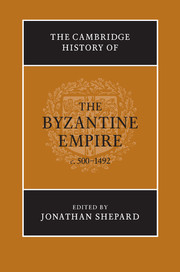Book contents
- Frontmatter
- General Introduction
- Part I The Earlier Empire c. 500–c. 700
- Part II The Middle Empire c. 700–1204
- Part III The Byzantine Lands in the Later Middle Ages 1204–1492
- 20 After the Fourth Crusade
- 21 Balkan Powers: Albania, Serbia and Bulgaria (1200–1300)
- 22 The Palaiologoi and the World Around Them (1261–1400)
- 23 Latins in the Aegean and the Balkans (1300–1400)
- 24 The Roman Orthodox World (1393–1492)
- Glossary (Including some Proper Names)
- Genealogical Tables and Lists of Rulers
- List of alternative place names
- Bibliography
- Picture Acknowledgements
- Index
- References
21 - Balkan Powers: Albania, Serbia and Bulgaria (1200–1300)
from Part III - The Byzantine Lands in the Later Middle Ages 1204–1492
Published online by Cambridge University Press: 28 March 2010
- Frontmatter
- General Introduction
- Part I The Earlier Empire c. 500–c. 700
- Part II The Middle Empire c. 700–1204
- Part III The Byzantine Lands in the Later Middle Ages 1204–1492
- 20 After the Fourth Crusade
- 21 Balkan Powers: Albania, Serbia and Bulgaria (1200–1300)
- 22 The Palaiologoi and the World Around Them (1261–1400)
- 23 Latins in the Aegean and the Balkans (1300–1400)
- 24 The Roman Orthodox World (1393–1492)
- Glossary (Including some Proper Names)
- Genealogical Tables and Lists of Rulers
- List of alternative place names
- Bibliography
- Picture Acknowledgements
- Index
- References
Summary
introduction
It is widely accepted that the fall of Constantinople in 1204 brought to its knees an empire already on the point of collapse, notably on its Balkan fringes, where three peoples showed new vigour: the Bulgarians, the Serbs and the Albanians. The boundaries between their lands were still very fluid, especially those between Bulgaria and Serbia, and each was at a different stage of evolution towards political and cultural autonomy. Bulgaria under the Asen dynasty, which broke with the Byzantines in 1185–7 and which in 1202 gained Byzantine recognition of its mastery over the lands from Belgrade to Sofia, represented the resurgence of an older state, though with rather different territorial boundaries. Even after two centuries of Byzantine dominance, Bulgaria retained distinctive political and cultural traditions which sustained its self-image as the major power in the Balkans, and, in consequence, implied Bulgarian rights over Constantinople itself.
In Serbia, Stefan Nemanja (c. 1165/8–96) had recently brought together the two old power centres of Raška and Duklja (the latter roughly corresponding to modern Montenegro). Duklja, it is true, retained strong particularist tendencies, and internecine strife within the family of the Nemanjids only made this worse. On the Dalmatian coast, Italian influences spawned short-lived communes, which barely managed to withstand the Serb princes’ attempts to absorb them into their realms; the best example is that of Kotor. In any event, Nemanja directed a push southwards from 1183, which enabled him to put pressure on Macedonia beyond Niš.
Information
- Type
- Chapter
- Information
- The Cambridge History of the Byzantine Empire c.500–1492 , pp. 779 - 802Publisher: Cambridge University PressPrint publication year: 2009
References
Accessibility standard: Unknown
- 1
- Cited by
